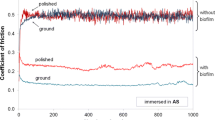Abstract
The effect of fluoride on the electrochemical behaviour of titanium was studied. Open circuit potentials, breakdown potentials (E b) and potentiostatic transient currents were measured in synthetic salivas of different compositions. Optical and scanning electron microscopic observations were also made. Results show that the growth rate of Ti oxide layer is affected by fluoride anions and tensile stresses are developed. The OCP/time relationship of Ti immersed in salivas A and B obeys a logarithmic law which depends on the saliva composition. The E b value is influenced by the thickness of the oxide layer, by the composition of the saliva (including fluoride concentration), and by the technique utilised for its evaluation. Thus, results reported in the literature, which seem to be contradictory, could be explained taking into account the experimental conditions assayed. A careful control of the titanium-containing dental materials should be made after long treatments with fluoride-containing prophylactic products or when fluoride-releasing restorative materials are present in the vicinity.
Similar content being viewed by others
References
G. Brankevich, M. Fernández Lorenzo de Mele and H.A. Videla, Marine Technol. Soc. J. 24 (1990) 18.
H.A. Videla, M. Fernández Lorenzo de Mele and G. Brankevich, Corrosion 44 (1988), 1988 423-6.
S.G. Gómez de Saravia, M. Fernández Lorenzo de Mele and H.A. Videla OEBALIA, XIX, Suppl. (1993) 231-58.
J. Gilbert, C.A. Buckley and E. Plautenshalger, J. Dent. Res 74 (IADR Abstracts) Abstract 645 (1995) 492.
J. Meyer, W.D. Müller, K. Seliger and J. Gilbert, J. Dent. Res 74 (IADR Abstracts) Abstract 590 (1995) 474.
A. Mombelli, D. Buser and N.F. Lang, Oral Microbiol. Immunol. 3 (1988) 113.
A. Leonhardt, J. Olsson and G. Dahlén, J. Dent. Res. 74 (1995) 1607.
M.C. Cortizo and M. Fernández Lorenzo de Mele, ‘Biofilm formation on dental metallic materials. Effect of fluoride anions’, Proc. 3rd. Latin American Symposium of Biodeterioration and Biodegradation (edited by C.C. Gaylarde, T.C.P. Barbosa, N.H. Gabilan), Br. Phycol. Soc., UK (1998), p. 18.
W.M. Edgar, M.A. Cockburn and G.N. Jenkins, Arch. Oral Biol. 26 (1981) 615.
G.H.W. Bowden and I.R. Hamilton, Oral Microbiol Immunol. 4 (1989) 57.
Y.H. Li and G.H. Bowden, J. Dent. Res. 73 (1994) 1615.
E.D. Hamilton and J. Arends, in E. Ekstrand, O. Fejerskov, L. Silverstone, (Eds.) ‘Fluoride Dentistry’ Munsksgoord, Copenhagen (1991), p. 77.
M.C. Cortizo and M. Fernandez Lorenzo de Mele, ‘Biodeteriora-tion of Dental Metallic Materials’, 2nd NACE Latin Am. Reg. Corrosion. Congress (1996), paper LA96149.
M.C. Cortizo and M. Fernandez Lorenzo de Mele, ‘Corrosion of Dental Alloys in Synthetic Saliva of Different Compositions. Effect of Biofilms’, International Materials Research Congress, Symposium 11 Biomaterials, CancÚn, Sept. (1998), paper 4.
N. Casillas, S. Charlebois and W.H. Smyrl, J. Electrochem. Soc. 141 (1994) 636.
L.C. Archibald and J.S.L. Leach, Electrochim. Acta 22 (1977) 21.
L.C. Archibald and J.S.L. Leach, Electrochim. Acta 22 (1977) 15.
T.R. Beck, J. Electrochem. Soc. 120 (1973) 1317.
T.R. Beck, J. Electrochem. Soc. 120 (1973) 1310.
D.G. Kolman and J.R. Scully, J. Electrochem. Soc. 142 (1995) 2179.
D.G. Kolman and J.R. Scully, J. Electrochem. Soc. 143 (1996) 1847.
I. Reclaru and M. Meyer, J. Dent. Res 74 (IADR Abstracts) Abstract 585 (1995) 474.
P. Wiig, J.E. Ellingsen and K. Videm, J. Dent. Res. IADR Abstracts 72 (1993) 195.
N. Rozenbajghier and L. Probster, J. Dent. Res. IADR Abstract 72 (1993) 227.
O. Riesgo and G. Duffo, ‘Corrosion of Titanium caused by Topical Fluoride’, Proc. of the XXV Annual Meeting of the Int. Assoc. Dental Research (Div. Argentina), Tandil (1993).
O. Riesgo and G. Duffo, ‘Corrosion of Titanium caused by Topical Fluoride’, Proc. of the XXVI Annual Meeting of the Int. Assoc. Dental Research (Div. Argentina), Cordoba (1994).
C. Baron, C.M. Marschoff and P.J. Aragon, J. Life Sci. 8 (1978) 105.
E. Quezada Castillo, MS thesis, Universidad Nacional General San Martin, Argentina (1997).
U.R. Evans, ‘The Corrosion and Oxidation of Metals’ (Arnold, London, 1960), p. 898.
M.S. El-Basiouny, A.M. El-Dot and M.M. Hefny, Corrosion 35 (1979) 566.
A.G. Gad-Allah and H.A. Abd El-Rahman, Corrosion 43 (1987) 698.
J.M. Abd El-Kader and A.M. Shams El-Din, Brit. Corros. J. 14 (1979) 40.
J.M. Abd El-Kader, F.M. Adb El-Wahab, H.A. El-Shayeb and M.G.A. Khedr, Brit. Corros. J. 16 (1981) 111.
Author information
Authors and Affiliations
Rights and permissions
About this article
Cite this article
Fernández Lorenzo de Mele, M., Cortizo, M. Electrochemical behaviour of titanium in fluoride-containing saliva. Journal of Applied Electrochemistry 30, 95–100 (2000). https://doi.org/10.1023/A:1003891000220
Issue Date:
DOI: https://doi.org/10.1023/A:1003891000220



